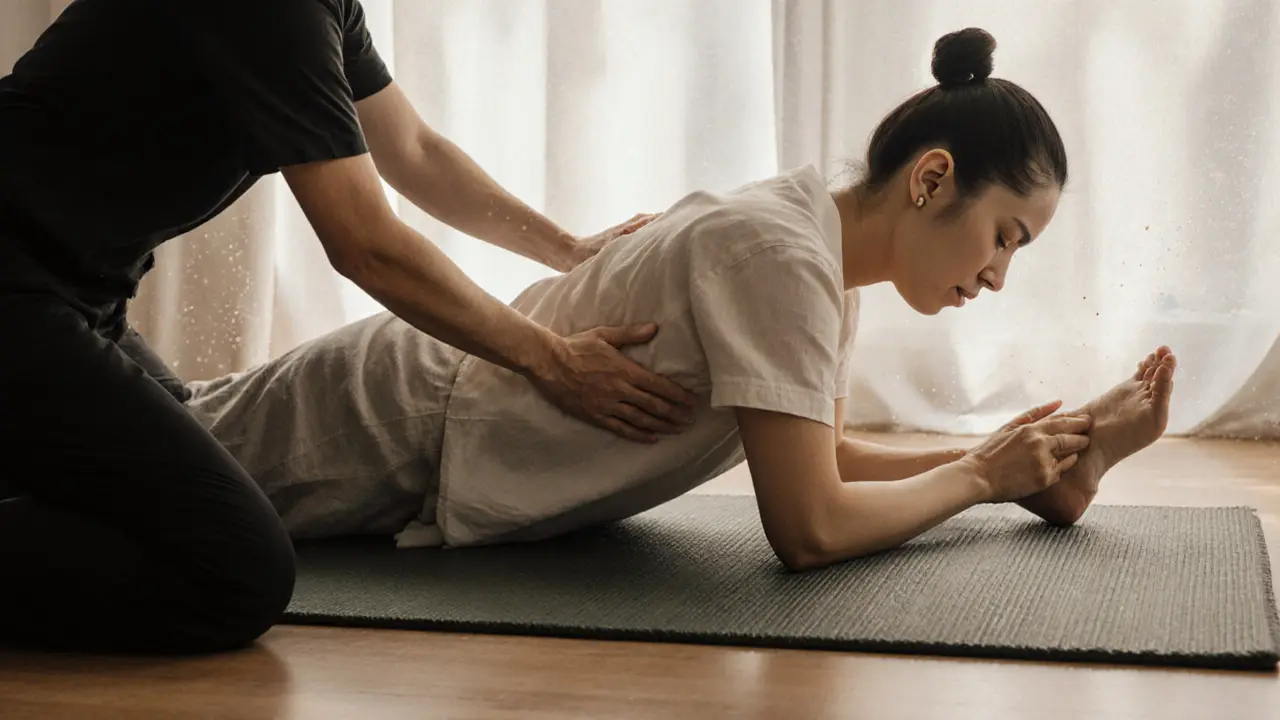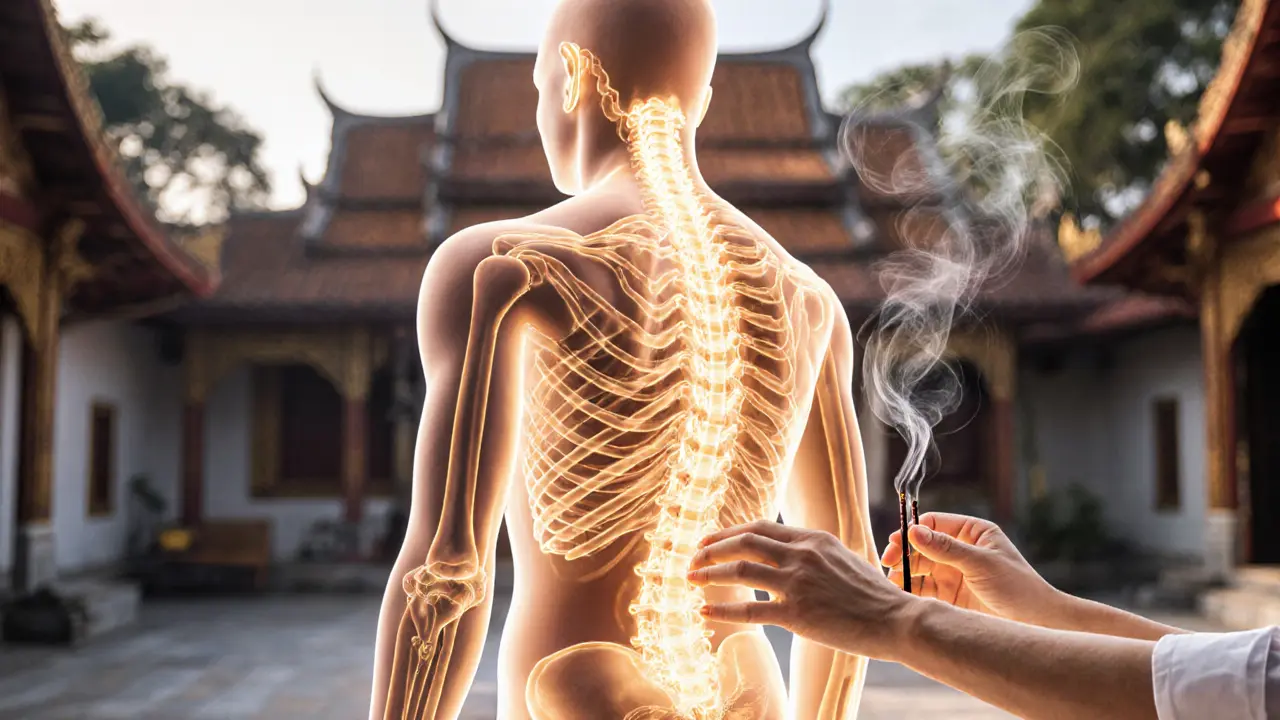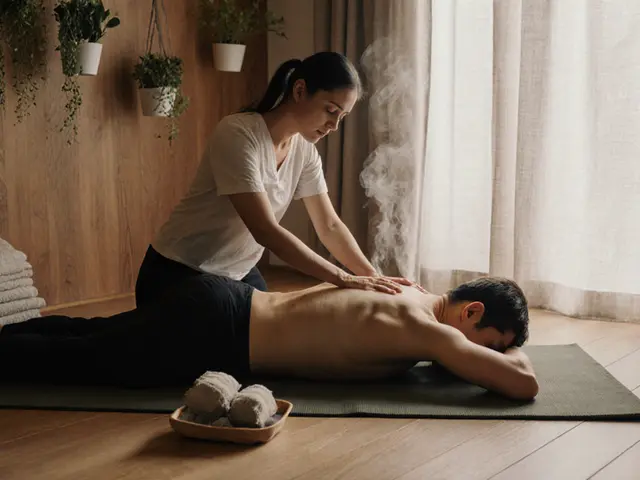Thai Massage: A Complete Guide to Techniques, Benefits, and What to Expect

Thai massage isn’t just another spa treatment. It’s a 2,500-year-old healing system that blends acupressure, assisted yoga postures, and energy line work. If you’ve ever walked out of a session feeling like you’ve been stretched, reset, and deeply relaxed all at once, you know it’s unlike anything else. But what’s actually happening during those 90 minutes? And why do people swear by it after chronic back pain, stress, or stiffness? This guide breaks down exactly how Thai massage works, what techniques are used, and the real benefits backed by experience-not just marketing.
How Thai Massage Is Different From Other Types
Most massages you’ve tried-Swedish, deep tissue, sports-focus on muscles. Thai massage works on something deeper: energy lines called sen lines. These aren’t nerves or blood vessels. They’re traditional Thai concepts of energy pathways, similar to meridians in Chinese medicine. There are 10 main sen lines running through the body, and practitioners apply pressure along them using thumbs, palms, elbows, knees, and even feet.
Unlike other massages where you lie still, Thai massage is interactive. You stay fully clothed-usually in loose cotton pants and a t-shirt-and the therapist moves you into stretches that feel like yoga, but with someone guiding your body gently into positions you couldn’t reach alone. No oils. No table. You lie on a mat on the floor. It’s more like a guided stretch session with deep pressure than a typical massage.
That’s why people often say it’s “intense” or “powerful.” It’s not about relaxation alone. It’s about releasing tension that’s locked in joints, tendons, and connective tissue. If you’ve ever had tight hips from sitting all day or shoulders that never feel loose, Thai massage targets those areas in ways other therapies can’t.
Core Techniques Used in Thai Massage
There are five key techniques that make Thai massage unique:
- Palming and Thumbing - The therapist uses the heel of the palm or the thumb to apply firm, rhythmic pressure along the sen lines. This isn’t light touch-it’s deep, deliberate pressure meant to stimulate energy flow.
- Assisted Stretching - You’re moved into yoga-like poses: forward bends, spinal twists, leg stretches. The therapist uses their body weight to gently guide you deeper into each stretch, holding for 10-20 seconds. This helps lengthen muscles and improve joint mobility.
- Joint Mobilization - Gentle rocking and rotation of shoulders, hips, ankles, and knees help restore natural movement. This isn’t cracking joints-it’s slow, controlled motion to reduce stiffness.
- Compression - The therapist uses their forearms, elbows, or knees to apply steady pressure to larger muscle groups like the back, thighs, and calves. It feels like a deep, warm hug that releases tension.
- Energy Line Work - Pressure is applied along the 10 sen lines, especially Sen Sumana (center line from head to tailbone), Sen Ittha (side of neck to shoulder), and Sen Kalathari (leg line). This is where the traditional healing aspect comes in.
Each session is tailored. If you have lower back pain, more time is spent on the legs and lower spine. If you’re stressed, the therapist focuses on the neck, shoulders, and head. No two sessions are identical.
Proven Benefits of Thai Massage
People don’t just feel good after Thai massage-they report real, measurable improvements. Here’s what research and long-term users consistently say:
- Reduces chronic pain - A 2018 study published in the Journal of Bodywork and Movement Therapies found that participants with lower back pain saw a 40% reduction in pain levels after six weekly Thai massage sessions.
- Improves flexibility - One session can increase hamstring flexibility by up to 20%, according to a small trial with office workers. After 4-6 sessions, range of motion in hips and shoulders improves significantly.
- Lowers stress hormones - Cortisol levels dropped by an average of 32% in participants after a single session, based on saliva tests from a 2021 study at Chiang Mai University.
- Boosts circulation - The rhythmic compression and stretching help move blood and lymph, reducing swelling and speeding up recovery after workouts.
- Enhances sleep quality - Many clients report falling asleep faster and sleeping more deeply in the nights following a session, likely due to nervous system calming.
It’s not magic. It’s biomechanics and traditional wisdom working together. The combination of deep pressure and active stretching resets the nervous system. Your body stops holding tension as a default.

What to Expect During Your First Session
Walking into your first Thai massage can feel intimidating if you’ve never done it. Here’s what actually happens:
- You’ll be asked to wear loose, comfortable clothing. No underwear changes needed-just something you can move in.
- You’ll lie on a thick mat on the floor. No massage table.
- The therapist will begin by asking about injuries, pain points, or areas you want to focus on.
- They’ll start at your feet and work upward, using slow, rhythmic pressure. You might feel some discomfort, but not sharp pain. If it’s too much, say so. Good therapists adjust on the spot.
- You’ll be moved into stretches. Some feel awkward. Others feel amazing. Don’t resist. Let your body go with it.
- The session lasts 60-120 minutes. Most first-timers choose 90 minutes.
- You’ll feel slightly sore the next day-like after a good workout. That’s normal. It means your muscles are releasing.
Afterward, drink water. Avoid caffeine or heavy meals for a few hours. Your body is processing the release of tension and toxins.
Who Should Avoid Thai Massage
Thai massage is safe for most people, but it’s not for everyone:
- Don’t get it if you have a recent fracture, severe osteoporosis, or an active blood clot.
- Avoid it during pregnancy unless you’re with a therapist trained in prenatal Thai massage.
- If you have severe arthritis, joint replacements, or recent surgery, talk to your doctor first.
- Don’t go if you’re feeling sick, feverish, or have an infection.
Therapists should always ask about your health history. If they don’t, walk away. A good session starts with safety.
How to Find a Qualified Thai Massage Therapist
Not everyone calling themselves a Thai massage therapist knows what they’re doing. Here’s how to find someone who does:
- Look for certification from a Thai institution like Wat Pho Temple in Bangkok, which is the most respected school.
- Ask if they’ve trained in Thailand. Many therapists in the West learned online or in weekend workshops-those skills don’t always translate to deep, safe work.
- Check reviews for mentions of “deep work,” “stretching,” or “energy flow.” Vague praise like “very relaxing” might mean it was just a light Swedish massage.
- Watch how they set up. A real Thai massage happens on a floor mat, not a table.
- Ask how long they’ve been practicing. Five years or more is a good sign.
Don’t be afraid to ask questions. A good therapist will welcome them.

How Often Should You Get Thai Massage?
There’s no one-size-fits-all answer. But here’s what most regular users follow:
- For chronic pain or stiffness: Once a week for 4-6 weeks, then every 2-3 weeks to maintain.
- For stress relief: Every 2-4 weeks.
- For athletes or physically active people: Once a week during intense training, every 2 weeks during maintenance.
- For general wellness: Once a month keeps your body moving well.
Think of it like brushing your teeth. You don’t wait until your gums bleed to start. Regular sessions prevent problems before they start.
Can You Do Thai Massage at Home?
You can’t fully replicate Thai massage alone-it needs two bodies. But you can learn simple self-care moves:
- Use a foam roller on your calves and thighs to mimic compression.
- Do seated forward folds and gentle spinal twists daily.
- Press your thumbs along the inside of your legs from knee to hip-this follows the Sen Kalathari line.
- Use a tennis ball against a wall to roll out your upper back.
These won’t replace a professional session, but they’ll keep your body limber between visits.
Is Thai massage painful?
It can feel intense, but it shouldn’t hurt. The pressure is deep, and stretches may challenge your flexibility, but sharp pain means you’re pushing too far. A good therapist will adjust based on your feedback. If you’re tense, tell them. It’s not a test of endurance-it’s a healing session.
Do I need to be flexible to try Thai massage?
No. Thai massage is designed for people who aren’t flexible. The therapist moves you gently into positions your body can handle. Many clients start stiff and end up feeling looser than they ever have. It’s not about how far you can stretch-it’s about releasing what’s stuck.
How long does a Thai massage session last?
Most sessions are 60, 90, or 120 minutes. First-timers usually start with 90 minutes. This gives enough time to cover the whole body without rushing. Shorter sessions focus on specific areas like back and legs.
Can Thai massage help with headaches?
Yes. Many people find relief from tension headaches because Thai massage releases tightness in the neck, shoulders, and upper back-the areas that often cause referred pain to the head. Therapists specifically work along the Sen Ittha line, which runs from the temple to the shoulder, helping to calm the nervous system.
What’s the difference between Thai massage and Shiatsu?
Both use pressure on energy lines, but Thai massage includes active stretching and uses the therapist’s whole body-elbows, knees, feet-to apply pressure. Shiatsu is mostly hand-based and done on a mat, but with less movement. Thai massage is more dynamic and physically engaging.
Next Steps: How to Start
If you’ve been curious about Thai massage, don’t wait for the “perfect time.” Start with one session. Book a 90-minute appointment at a place with good reviews and certified therapists. Wear comfortable clothes. Drink water afterward. Pay attention to how your body feels the next day.
Many people don’t realize how much tension they carry until it’s released. Thai massage doesn’t just relax you-it helps you feel your body again. And in a world full of screens and stress, that’s worth more than a quick fix.





